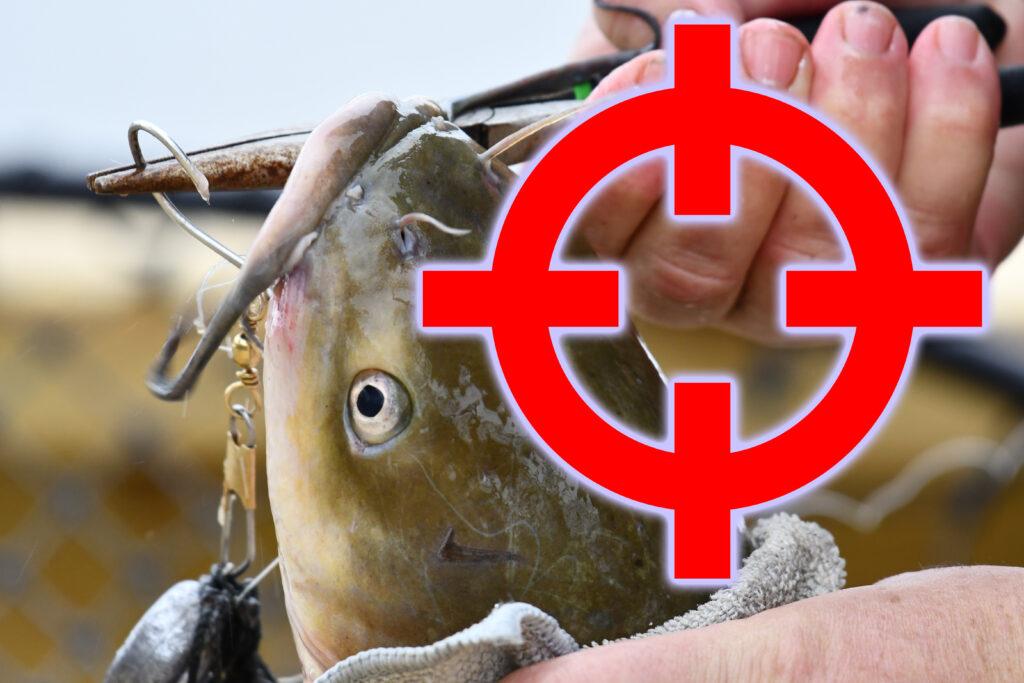Catfish live within rivers, lakes, and ponds. Coastal bodies of water, including bays, also have catfish. Catfish are found throughout the majority of the United States.
Top 10 Places Catfish Live
Each type of body of water, such as lakes, rivers, and ponds, offers a different type of environment for catfish to live within. This guide helps anglers locate and identify the different places where catfish live. Couple this article with The Ultimate Guide to the Best Catfish Bait, and you’ll be catching catfish in no time
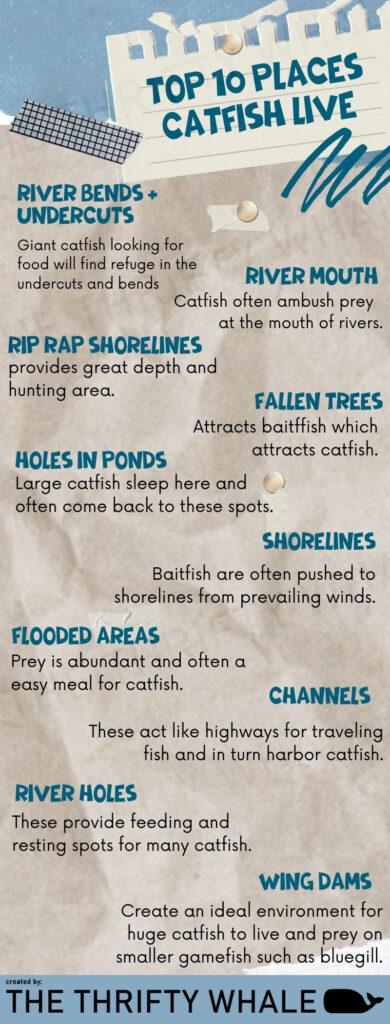
River Bends & Undercuts
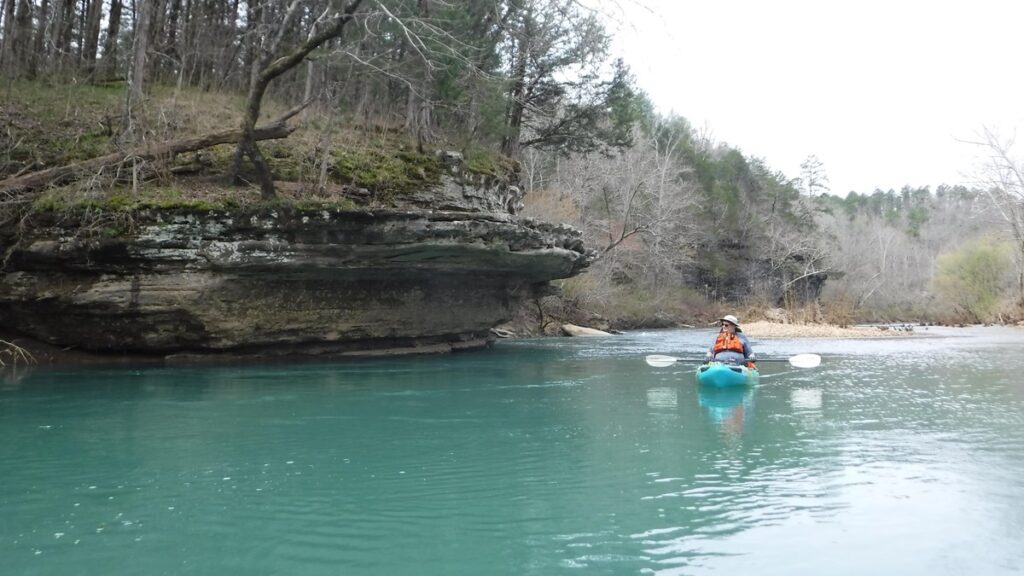
A river’s flow follows the path that is least resistant. If the river is blocked by hard bottom, it will change its direction and form a hard-bottomed bend that flows with the current. These bends are where catfish live.
Another place to look is within undercuts—these form when the river erodes the bank and creates a cavity under the shoreline. Catfish looking for food will live in undercuts and ledges. Catfish do not have scales but have a thick outer slime that protects them. Because of this slime, they can easily burrow and hide within undercuts. Our article, Do Catifsh Have Scales? goes into greater detail about their slime.
To locate bends and undercuts, study the water. Look for swirling pools to spot deeper water.
As you become more familiar with how the water flows, you will locate where the catfish in your area live.
The Mouth of a River
River mouths, also called tributary mouths, are used as staging areas for pre-spawn or post-spawn catfish. Catfish live in these areas. When a river meets a larger body of water, such as a lake or bay, it is considered a mouth of a river. Fishing the mouth of rivers produce great trophy catfish all year round if it is deep enough with abundant baitfish.
River mouths have catfish living within them because catfish ambush their prey near current breaks, humps, holes, or trees. A tributary joining a larger body of water often has a lot of different types of cover, which allows catfish to hunt and then lazily “sleep” between meals.
When fishing in these areas, be mindful of the underwater cover, such as fallen trees. Some use floater rigs in these situations, allowing the bobber to float past the cover. The catfish that live there will often come out and strike the bait. Our guide, The Best Catfish Rig for Bank Fishing, details floater rigs and other great setups to use while fishing at the mouth of a river.
Rip Rap Shorelines
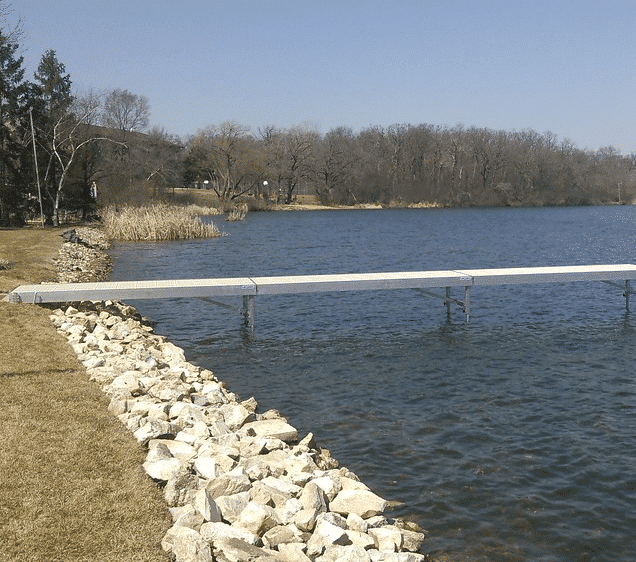
Rip rap is a collection of large rocks placed along the shorelines to stop erosion. Engineers often use it near bridges, dams, and boat ramps. Catfish live near rip rap because it provides a quick change of depth in the water, attracts baitfish and small animals, and provides shade and cover. This habitat is especially popular with large channel cats.
When fishing in these locations, make sure to look for other structures in the water aside from the rip rap shoreline.
Catfish live within or under fallen trees and other covers that have settled along rip rap. You are bound to find catfish if you find a rip rap shoreline with many different water structures. These are great places to deploy a set of jugs for jug fishing. Our article What is Jug Fishing? will show you how to make a great setup to catch catfish along rip rap shorelines.
Because there are usually large depth differences near rip rap shorelines, you have to be able to rig up different catfish rigs. Usually, the water is relatively open and allows you to fish in many different styles here.
Fallen Trees
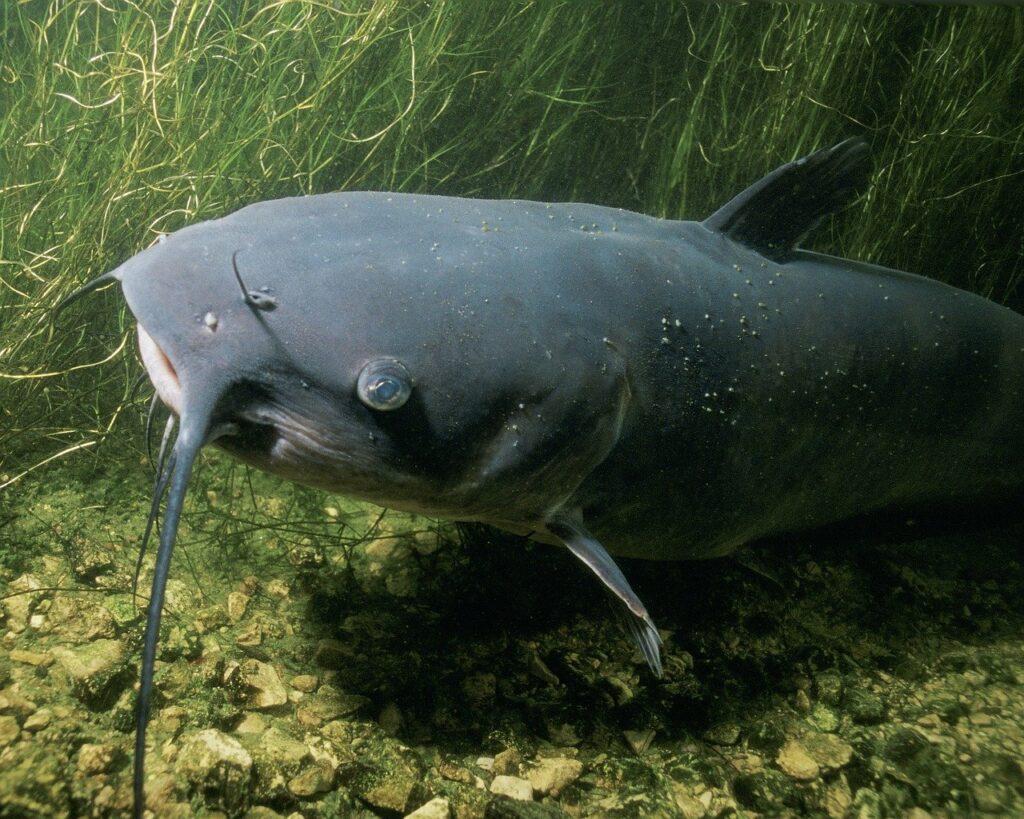
There are two types of tree structures that catfish like to live near. One is a float log structure that usually builds up over time and presses against the shoreline. Another place catfish live is within the network of branches provided by trees that have fallen into the water.
Both types of tree structures provide an excellent place for catfish to live.
Log floats lend to larger structures, and this is where giant catfish live. There is often a swirl of water, or eddies, near log floats that attract baitfish to the area. The trophy catfish will be under the float, near the shoreline, waiting for an opportunity. These log floats take up an enormous area within the river or body of water you are fishing. If that’s the case, take your time and try different catfish baits throughout the day to see what works.
Fallen trees are also an excellent place for catfish to live. The problem with these areas is the network of branches that easily tangle your fishing line. It takes practice, but you will pull some trophy catfish out with a well-cast lure or cut bait.
Deep Holes In Ponds
Catfish live in the deeper holes in ponds during the spring, fall, and winter but often leave these areas during the summer due to the drop in oxygen.
Holes within ponds are great to find catfish during the day because they usually retreat to these darker areas after their morning hunt. These holes are where they live and come back to when finished hunting in the morning or night.
To catch these catfish, send out a bottom-fishing rig with alive or cut bait to entice them out of their hole. Live bait works well in these scenarios because the catfish smells the bait and see the movement that sparks interest. Another great option is catfish stink bait. Due to their smell, these baits are designed to lure catfish out of holes in ponds and other areas.
Shorelines
Catfish live and hunt along shorelines. These areas provide a change of depth and many different structures for baitfish and prey.
A great way to fish shorelines is when the wind is blowing hard. To do this, identify which shorelines are being windswept and go there.
When a shoreline windswept, it pushes the smaller fish toward that area. The catfish will follow because they are after the baitfish.
Flooded Areas
Catfish live within flooded areas because they are rich in various baits such as worms, crayfish, baitfish, and more.
Flood areas create a perfect home for catfish because they provide easy access to areas of water that are shallow where prey is abundant, coupled with deeper places where they rest and wait for their next meal.
A well-rigged Santee Cooper rig is a great way to fish for catfish in these flooded areas. If fishing from the bank, bring some baitfish to cut and place onto the hook. Another alternative is to fish for baitfish within the flooded area. once caught, bluegill, crappie, and perch are all excellent bait for fishing catfish in flooded areas. Lastly, worms are a great choice in flooded areas. They naturally rise to the surface and get displaced once rains come. To learn more about fishing with worms, check out How to Grow Worms for Fishing.
Channels
Catfish live in channels because of the slack water and the opportunity to ambush baitfish. Rivers, lakes, and even bays often feature prominent bottom channels. Years of water flow and dredging out for boats to easily navigate shallower waters (often the case in bays) create ideal channels for catfish.
Channels also act as highways and lead migrating catfish to different parts of the water bodies. The small branches are secondary roads that lead migratory fish to shallow-water habitats.
If you take the time to plot out an area for channels, you will begin to see how it is all a roadmap of travel for fish. Catfish live in the regions where channels intersect and drop off. They love to find an easy meal, and there’s no better place for them to live than channels within rivers, lakes, and bays.
Another consideration when seeking out channels is to look for underwater features such as fallen trees and other structures. You will find where the catfish live by combining semi-temporary structures with deep channels.
River Holes
Although sometimes hard to find, river-bottom holes are where big catfish live.
Like the wing dams, a river hole splits up the current and provides feeding and resting spots for many catfish, including blues, channels, and flatheads.
Holes form in smaller rivers where the current washes away the bottom substrate. When this happens, the bedrock is often exposed. This creates a spot available to the catfish year-round and is a great place to fish consistently throughout the year.
You will find large-river holes near dams, outside bends, and tributary mouths.
Sonar is an excellent way to identify this structure. If you don’t have sonar or are fishing for catfish on the shore, study the water for a time and look for swirls and tiny bubbles. These indicators often mark a change in the river’s structure and help you pinpoint where the catfish live.
Catfish that live in these holes will wait for food to come near them. Identifying river holes will help you concentrate on the most productive areas. Finding where the catfish live will equate to more caught fish at the end of the day.
Wing Dam
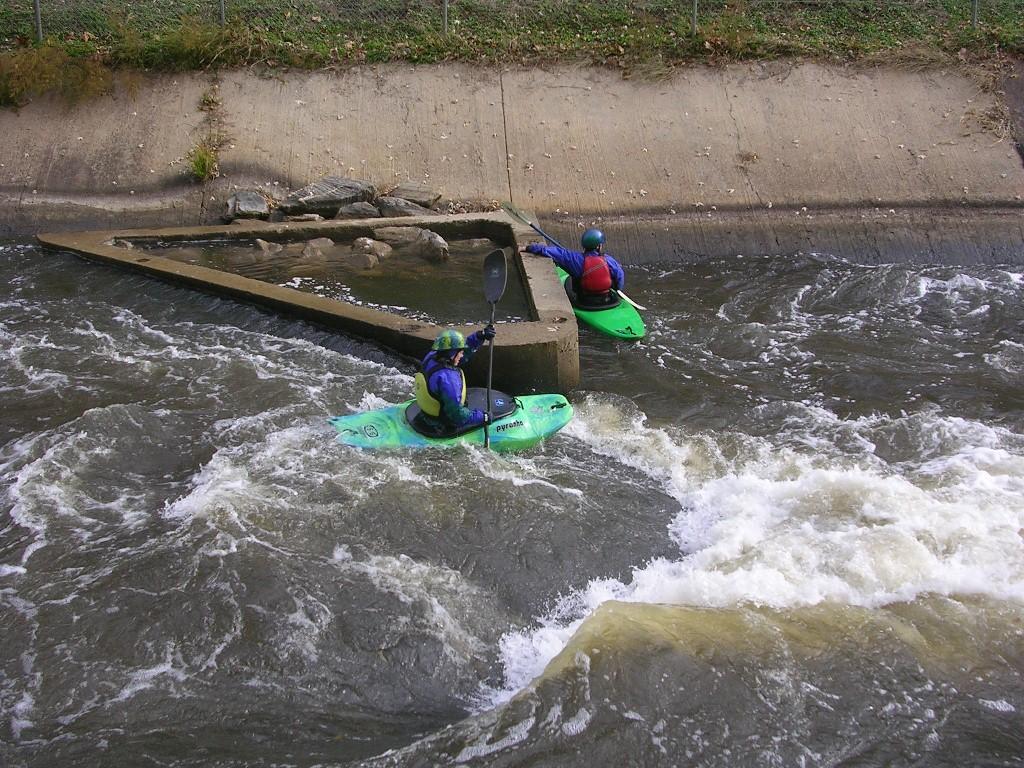
Catfish live on the lower portion of wing dams. Here, fast-moving water swirls, and the depth of the river increases. This allows catfish to sit in the deeper parts of the river and wait for baitfish and other food to drift by.
Wing dams, also known as wing dikes, are created by people and only extend partially into the water. The purpose of wing dams is to reduce sediment accumulation by forcing water into the center of the river. This creates an ideal environment for huge catfish to live and prey on smaller gamefish such as bluegill.
This zone is food-rich and hungry catfish stay there without consuming too much energy.
An excellent method to catch these catfish is to drop a weighted lure into the circular whirlpools to target big cats. These prime feeding areas usually have a surplus of catfish and even some trophies.
There’s an abundance of catfish in most lakes. They live near structure, in the deeper portions of the lakes where the depth changes rapidly, and near other structure that is unique to the lake.
The Wels Catfish lives in eastern and now western Europe. It is native to the basins of the Blatic, Black, and Caspian sea and have recently been found in the United Kingdom.
Channel catfish live within freshwater and prefer to be near the bottom. They are found in freshwater streams, rivers, lakes, and even bays near structure such as fallen trees, logs, and rip rap shorelines.
The redtail catfish live in the Amazon basins’ rivers, streams, lakes, and ponds. It lives only in freshwater.
Blue catfish live in freshwater river basins and are native to Mississippi, Missouri, and Ohio.
Flathead catfish are found throughout the United States in freshwater bodies of water but are native to the Mississippi, Missouri, and Ohio river basins and some areas of Mexico.
Most catfish live in freshwater bodies of water and prefer to be near the bottom, surrounded by cover such as fallen trees.
